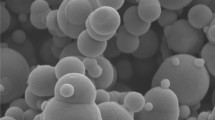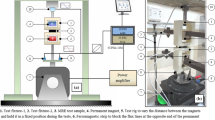Abstract
Background
As a new type of magnetic sensitivity smart material, magnetorheological elastomers (MRE) showing a good magnetorheological effect have a wide application prospect in the field of intelligent structures and devices.
Purpose
To accurately characterize the dynamic mechanical behavior of MRE under varying strain amplitudes, frequencies, and magnetic fields, the viscoelastic fractional derivative was introduced, and a phenomenological model with fractional derivative was proposed to depict the hysteresis loops of MRE.
Methods
The micro-structure characteristics of MRE with varying mechanical properties were analyzed. The effects of strain amplitudes, frequencies, and magnetic fields on the dynamic viscoelasticity of MRE were studied experimentally. On this basis, the phenomenological model with fractional derivative was established. A parameter identification method was proposed to obtain the prediction model considering the current factor. The parameters of the prediction model were identified by using the GA-PSO optimization algorithm, and the identification results were verified.
Results
The storage and loss modulus of MRE first remain unchanged and then decrease with the increasing strain amplitudes (0 ~ 100%); and increase with the ascending frequencies (0 ~ 100 Hz); and increase with the increasing magnetic fields (0 ~ 545 mT), showcasing a significant magnetorheological effect. The numerical results of MRE’s stress and strain are in good agreement with the experimental results, and the fitness values exceed 70%, showcasing the effectiveness of the fractional derivative phenomenological model and the feasibility of the parameter identification method.
Conclusions
The prediction model can accurately characterize the dynamic mechanical behavior of the MRE under varying strain amplitudes, frequencies, and current intensities, laying a foundation for the engineering application of MRE.



















Similar content being viewed by others
References
Dong X, Ma N, Qi M, Li J, Chen R, Ou J (2012) The pressure-dependent MR effect of magnetorheological elastomers. Smart Mater Struct 21:416–422
Sun S, Yang J, Du H, Li W (2018) Overcoming the conflict requirement between high-speed stability and curving trafficability of the train using an innovative magnetorheological elastomer rubber joint. J Intell Mater Syst Struct 29:214–222
Ahamed R, Choi SB, Ferdaus MM (2018) A state of art on magneto-rheological materials and their potential applications. J Intell Mater Syst Struct 29:2051–2095
Zhang J, Pang H, Wang Y, Gong X (2020) The magneto-mechanical properties of off-axis anisotropic magnetorheological elastomers. Compos Sci Technol. 191:108079
Fan Y, Gong X, Xuan S, Qin L, Li X (2013) Effect of cross-link density of the matrix on the damping properties of magnetorheological elastomers. Ind Eng Chem Res 52:771–778
Jolly MR, Carlson JD, Munoz BC (1996) A model of the behaviour of magnetorheological materials. Smart Mater Struct 5:607–614
Davis L (1999) Model of magnetorheological elastomers. J Appl Phys 85:3348–3351
Shen Y, Golnaraghi MF, Heppler GR (2004) Experimental research and. J Intell Mater Syst Struct 15:27–35
Chen L, Gong XL, Li WH (2007) Microstructures and viscoelastic properties of anisotropic magnetorheological elastomers. Smart Mater Struct 16:2645–2650
Zhang X, Peng S, Wen W, Li W (2008) Analysis and fabrication of patterned magnetorheological elastomers. Smart Mater Struct 17:45001–45005
Hemmatian M, Sedaghati R, Rakheja S (2020) Characterization and. Smart Mater Struct 29:115001
Wang B, Kari L (2020) A visco-elastic-plastic constitutive model of isotropic magneto-sensitive rubber with amplitude, frequency and magnetic dependency. Int J Plast 132:102756
Li WH, Zhou Y, Tian TF (2010) Viscoelastic properties of MR elastomers under harmonic loading. Rheologica Acta 49:733–740
Kari L, Blom P (2005) Magneto-sensitive rubber in a noise reduction context-exploring the potential. Plast Rubber Compos 34:365–371
Chen L, Jerrams S (2001) A rheological model of the dynamic behavior of magnetorheological elastomers. J Appl Phys 110:013513
Xu ZD, Xu C, Hu J (2015) Equivalent fractional Kelvin model and experimental study on viscoelastic damper. J Vib Control 21:2536–2552
Blom P, Kari L (2011) A nonlinear constitutive audio frequency magneto-sensitive rubber model including amplitude, frequency and magnetic field dependence. J Sound Vib 330:947–954
Zhu JT, Xu ZD, Guo YQ (2012) Magnetoviscoelasticity parametric model of an MR elastomer vibration mitigation device. Smart Mater Struct 21:075034
Behrooz M, Wang X, Gordaninejad F (2014) of a new semi-active/passive magnetorheological elastomer isolator. Smart Mater Struct 23:045013
Ikhouane F, Mañosa V, Rodellar J (2007) Dynamic properties of the hysteretic Bouc–Wen model. Syst Control Lett 56:197–205
Dominguez A, Sedaghati R, Stiharu I (2004) Modelling the hysteresis phenomenon of magnetorheological dampers. Smart Mater Struct 13:1351
Yang J, Du H, Li W, Li Y, Li J, Sun S, Deng HX (2013) Experimental study and. Smart Mater Struct 22:117001
Wang Q, Dong X, Li L, Ou J (2017) A nonlinear model of magnetorheological elastomer with wide amplitude range and variable frequencies. Smart Mater Struct. 26:065010
Wang HX, Gong XS, Pan F, Dang XJ (2015) Experimental investigations on the dynamic behaviour of o-type wire-cable vibration isolators. Shock Vib. https://doi.org/10.1155/2015/869325
Rodriguez A, Iwata N, Ikhouane F, Rodellar J (2008) and identification of a large-scale magnetorheological fluid damper. Adv Sci Technol Trans Tech Publ Ltd 56:374–379
Zhu H, Rui X, Yang F, Zhu W, Wei M (2019) An efficient parameters identification method of normalized Bouc–Wen model for MR damper. J Sound Vib 448:146–158
Giuclea M, Sireteanu T, Stancioiu D, Stammers CW (2004) Model. Proc Inst Mech Eng Part I J Syst Control Eng 218:569–581
Charalampakis AE, Koumousis VK (2008) Identification of Bouc–Wen hysteretic systems by a hybrid evolutionary algorithm. J Sound Vib 314:571–585
An JS, Kwon SH, Choi HJ et al (2017) Modifified silane-coated carbonyl iron/natural rubber composite elastomer and its magnetorheological performance. Compos Struct 160:1020
Tong Y, Dong X, Qi M (2018) Improved field-induced storage modulus tunable range by using flower-like particles as the active phase of magnetorheological elastomers. Soft Matter. 14:3504
Chang YJ, Tian WW, Chen EL, Shen YJ, Xing WC (2020) Dynamic model for the nonlinear hysteresis of metal rubber baser on the fractional-order derivative. J Vib Shock 39:233–241
Oustaloup A, Levron F, Mathieu B, Nanot FM (2000) Frequency-band complex noninteger differentiator: characterization and synthesis. IEEE Trans Circ Syst I Fund Theory Appl 47:25–39
You H, Shen Y, Xing H, Yang S (2018) Optimal control and parameters design for the fractional-order vehicle suspension system. J Low Freq Noise Vib Active Control 37:456–467
Liu Y, Yang S, Liao Y (2011) A quantizing method for determination of controlled damping parameters of magnetorheological damper models. J Intell Mater Syst Struct 22:2127–2136
Banks A, Vincent J, Anyakoha C (2008) A review of particle swarm optimization. Part ii: hybridisation, combinatorial, multicriteria and constrained optimization, and indicative applications. Natl Comput. 7:109–124
Bi K, Qiu T (2019) An intelligent SVM modeling process for crude oil properties prediction based on a hybrid GA-PSO method. Chin J Chem Eng 27:1888–1894
Chen J, Li H (2019) Airfoil optimization of land-yacht robot based on hybrid PSO and GA. Int J Pattern Recogn Artif Intell 33:1959041
Garg H (2016) A hybrid PSO-GA algorithm for constrained optimization problems. Appl Math Comput 274:292–305
Acknowledgements
The authors thank the State Key Laboratory of Mechanical Behaviour in Traffic Engineering Structure and System Safety for providing equipments to the experiment. The present work is supported by the National Key R&D Program (2020YFB2007700), National Natural Science Foundation of China (Nos. 11790282, 12032017, 12172235, 12072208 and 52072249), the Opening Foundation of State Key Laboratory of Shijiazhuang Tiedao University (ZZ2021-13), and the Postgraduate Foundation of Hebei Province (CXZZBS2021112).
Author information
Authors and Affiliations
Corresponding author
Additional information
Publisher's Note
Springer Nature remains neutral with regard to jurisdictional claims in published maps and institutional affiliations.
Rights and permissions
About this article
Cite this article
Wang, P., Yang, S., Liu, Y. et al. Experimental Study and Fractional Derivative Model Prediction for Dynamic Viscoelasticity of Magnetorheological Elastomers. J. Vib. Eng. Technol. 10, 1865–1881 (2022). https://doi.org/10.1007/s42417-022-00488-x
Received:
Revised:
Accepted:
Published:
Issue Date:
DOI: https://doi.org/10.1007/s42417-022-00488-x




